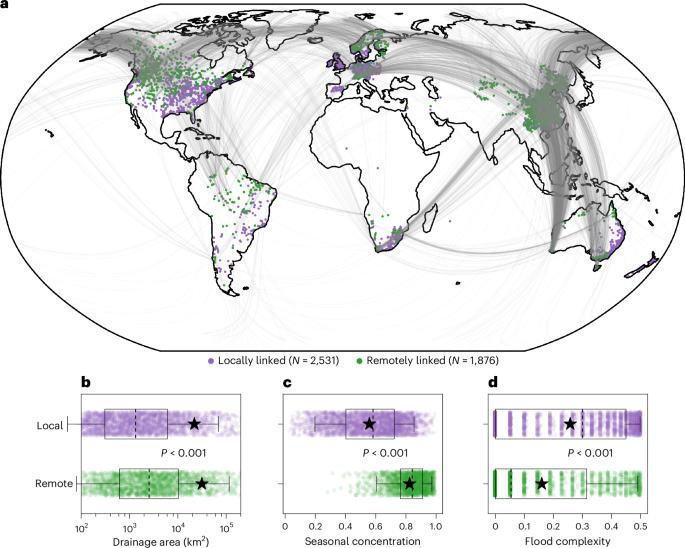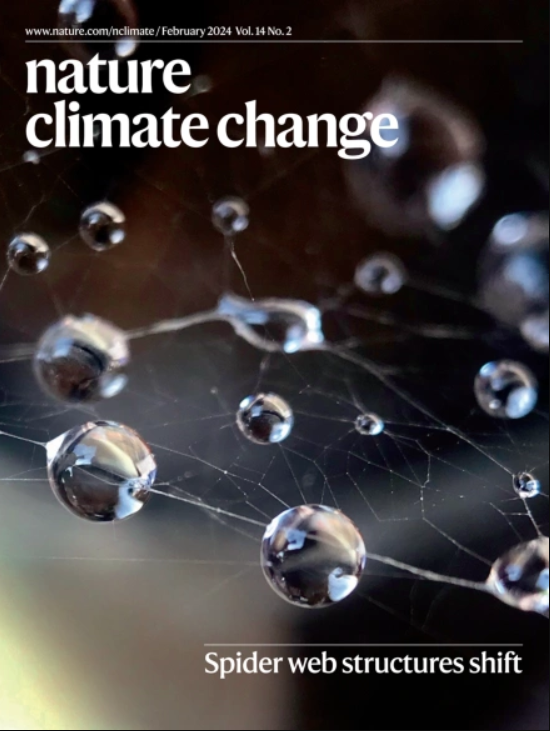20世纪80年代以来全球河流峰值流量同步
IF 27.1
1区 地球科学
Q1 ENVIRONMENTAL SCIENCES
引用次数: 0
摘要
与单个事件相比,同时发生在多个地区的河流洪水往往会导致更大的社会和环境影响。然而,控制河流峰值流量在空间上远近位置的全球互联的模式和机制在很大程度上仍未被探索。在这里,基于来自4,407个观测水文站的全球年峰值流量数据库,我们确定了跨越数千公里的远程链接流量峰值的中心。我们发现,远程连接的流域数量和总流域面积呈增加趋势,这表明自20世纪80年代以来,全球河流峰值流量的同步化程度增强。海洋-大气振荡通过温度和降水异常的扰动,决定了全球耦合模式和排放峰的时间演变。我们的研究结果强调了气候变暖下全球河流流量峰值的新概况,这有利于协调洪水风险管理。在多个地点同时发生的河流洪水可能比单个事件造成更大的损失。在这里,作者表明,在过去的几十年里,河流同时高流量的可能性有所增加。本文章由计算机程序翻译,如有差异,请以英文原文为准。

Synchronization of global peak river discharge since the 1980s
Riverine floods that occur simultaneously over multiple regions often lead to amplified societal and environmental impacts compared to individual events. However, the pattern and mechanisms governing the global interconnection of peak river discharge across spatially distant and proximate locations remain largely unexplored. Here, on the basis of a global annual peak discharge database from 4,407 observational hydrometric stations, we identify hubs for remotely linked discharge peaks spanning thousands of kilometres. We show increasing trends in the number of remotely linked watersheds and the total drainage area, pointing to amplified synchronization of global peak river discharge since the 1980s. Ocean–atmosphere oscillations, through the perturbation of both temperature and precipitation anomalies, dictate the global coupling pattern and temporal evolution of discharge peaks. Our findings highlight an emergent profile of global peak river flow in a warming climate that can benefit coordinated flood risk management. River floods that occur simultaneously in multiple locations can lead to higher damages than individual events. Here, the authors show that the likelihood of concurrent high river discharge has increased over the last decades.
求助全文
通过发布文献求助,成功后即可免费获取论文全文。
去求助
来源期刊

Nature Climate Change
ENVIRONMENTAL SCIENCES-METEOROLOGY & ATMOSPHERIC SCIENCES
CiteScore
40.30
自引率
1.60%
发文量
267
审稿时长
4-8 weeks
期刊介绍:
Nature Climate Change is dedicated to addressing the scientific challenge of understanding Earth's changing climate and its societal implications. As a monthly journal, it publishes significant and cutting-edge research on the nature, causes, and impacts of global climate change, as well as its implications for the economy, policy, and the world at large.
The journal publishes original research spanning the natural and social sciences, synthesizing interdisciplinary research to provide a comprehensive understanding of climate change. It upholds the high standards set by all Nature-branded journals, ensuring top-tier original research through a fair and rigorous review process, broad readership access, high standards of copy editing and production, rapid publication, and independence from academic societies and other vested interests.
Nature Climate Change serves as a platform for discussion among experts, publishing opinion, analysis, and review articles. It also features Research Highlights to highlight important developments in the field and original reporting from renowned science journalists in the form of feature articles.
Topics covered in the journal include adaptation, atmospheric science, ecology, economics, energy, impacts and vulnerability, mitigation, oceanography, policy, sociology, and sustainability, among others.
 求助内容:
求助内容: 应助结果提醒方式:
应助结果提醒方式:


